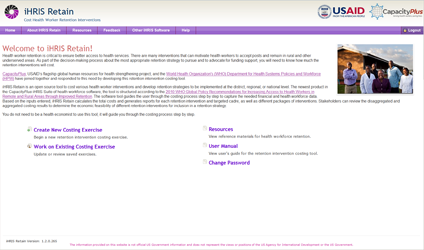
New Resource Spotlight: iHRIS Retain, a Tool for Costing Plans to Keep Health Workers in Rural Areas
People living in rural and remote areas of the world need more skilled health workers to care for their communities. However, attracting and retaining health workers to serve these areas is a challenge. Although nearly half of the world’s population lives in rural areas, they are served by less than 38% of the world’s nurses, and less than a quarter of the world’s doctors.
How can governments and other health care providers encourage health workers to serve in the areas that need them most? CapacityPlus has developed two powerful tools to address this challenge: the Rapid Retention Survey Toolkit and a companion software product, iHRIS Retain. iHRIS Retain was developed in collaboration with the World Health Organization (WHO).
The tools build on the WHO's 2010 global policy recommendations, which offer guidance on the different interventions in the areas of education, regulation, financial incentives, and professional development that can increase access to health workers in remote and rural areas through improved retention.
No single intervention is a “magic bullet,” and different health worker cadres may respond differently to the same intervention. The WHO recommends using a combination of interventions that are cadre-specific and contextual. The Rapid Retention Survey Toolkit is designed to enable health workforce managers and other decision-makers and then to determine health worker job preferences to develop the most attractive packages.
However, a minister of health or a health workforce manager may wonder: How much will these retention interventions cost over time? What can we afford?  In response, CapacityPlus and the WHO created iHRIS Retain, the newest addition to the iHRIS platform of tools for the health workforce, to cost retention strategies at the district, regional, or national level.
In response, CapacityPlus and the WHO created iHRIS Retain, the newest addition to the iHRIS platform of tools for the health workforce, to cost retention strategies at the district, regional, or national level.
The freely available, open source software tool guides the user through the costing process step by step to capture the needed financial and health workforce data. Based on the inputs entered, iHRIS Retain calculates the total costs and generates reports for each retention intervention and targeted cadre, as well as different packages of interventions and ultimately the aggregated cost of the retention strategy, and compares it to available health sector funds. The resulting cost figures can then be shared with stakeholders to determine the feasibility of the retention interventions and to budget for actual implementation.
Rachel Deussom, one of CapacityPlus’s health workforce officers, tested the tool in its final development stages. “iHRIS Retain guides the user through a simple, but comprehensive six-step process to account for the costs associated with planning, implementing, and managing different intervention activities that could contribute to a retention strategy,” she explains. “It is then possible to strategically group these activities into various packages, and compare them with each other and to your health sector budget. You can easily produce reports and charts that demonstrate their reach and share them with other stakeholders.”
Deussom notes that the back-end data are also available to users. “You don’t need to have a high-level economics degree,” she observes, and “you can also download data inputs right into Excel. iHRIS Retain makes costing a health worker retention strategies wonderfully accessible.”
When stakeholders design an affordable, cost-effective health worker retention strategy themselves, the result is more sustainable and rural community health will benefit.
Related items:


